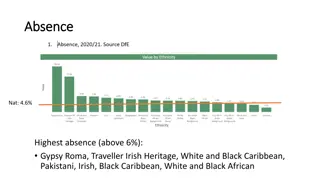Special Dilatonic Dyon-Like Black Hole Solutions in Two-Field Model
A class of special dilatonic dyon-like black hole solutions in a model with two Abelian gauge fields and two scalar fields is explored. Motivation for the study includes dimensional reduction of supergravity models and manifestations of dark matter. The solutions involve black hole dyon solutions, a dyonic-like black hole solution form, and scalar curvature calculations for the metric. The research is conducted by Al-Farabi Kazakh National University and RUDN University.
Download Presentation

Please find below an Image/Link to download the presentation.
The content on the website is provided AS IS for your information and personal use only. It may not be sold, licensed, or shared on other websites without obtaining consent from the author.If you encounter any issues during the download, it is possible that the publisher has removed the file from their server.
You are allowed to download the files provided on this website for personal or commercial use, subject to the condition that they are used lawfully. All files are the property of their respective owners.
The content on the website is provided AS IS for your information and personal use only. It may not be sold, licensed, or shared on other websites without obtaining consent from the author.
E N D
Presentation Transcript
A CLASS OF SPECIAL DILATONIC DYON-LIKE BLACK HOLE SOLUTIONS IN THE MODEL WITH TWO ABELIAN GAUGE FIELDS AND TWO SCALAR FIELDS 1 F. Belissarova, K. Boshkayev, A. Malybayev Al Farabi Kazakh National University V. Ivashchuk Institute of Gravitation and Cosmology, RUDN University; Center for Gravitation and Fundamental Metrology, VNIIMS THE FIFTH INTERNATIONAL CONFERENCE ON PARTICLE PHYSICS AND ASTROPHYSICS Moscow, Russia 2020
Black hole dyon solutions 2 The 4d model with two scalar fields and two 2-forms, governed by the action 1 1 1 g ( ) ( ) 1 ( ) ( ) 2 1 2 = 2 2 4 1 2 S d x g R g e F F e F F (1) 16 2 2 G = ( ) g g x dx dx where is metric, = 1 2 ( , ) 1 is the vector of scalar fields, = = is the 2-form, ( ) ( ) i i i F dA F dx dx 2 0 , are dilatonic coupling vectors = = ( ) ( ) 0 1 1 2 2 i i 2 , 1 = i = ( ) ( ) i i A dx A 2/10 RUDN University and Al- Farabi Kazakh National University
Motivation 3 The main motivation for considering this and more general 4D models is coming from dimensional reduction of supergravity or superstring induced models. One may consider a part of bosonic sector of dimensionally reduced 11d supergravity (either originating from 11d metric or coming from 4-form) (Chern- Simons terms do not give contribution to the solution in this case). Another motivation may be coming from possible local manifestation of dark matter or energy. 2/10 RUDN University and Al- Farabi Kazakh National University
Black hole dyon solutions 4 Adyonic-like black hole solution have the following form = 1 H H ds 2 2 dR (2) + + 2 2 2 2 2 2 a a dt R d 2 R 1 R P 2 Q , ( ) (3) =1 + + = H 2 P P 2 R ( ) 2 ( ) ( ) + 1 , , 2 1 2 , 2 2 (4) 0 = = + + 2 1 2 2 1 2 a 1 2 (5) 2 , 1 = i = ( 2 i i ln H ) ( ) + + (6) = i 1 1 2 2 1 1 2 i i Q 2 , ( (7) = d d ) 2 ( = ) 1 ( sin 1 F Q F dt dR 2 2 H ) Q R ) ( ( ) + + + (8) , , 0 = 2 2 2 = 1 1 2 2 2 2 Q Q 2 1 2 Q 1 2 i 1 2 Q Q 0 = Here , are (colored) charges electric and magnetic, respectively is the extremality parameter sin d d + 1 2 d 2 2 2 2 2 3/10 RUDN University and Al - Farabi Kazakh National University
Black hole dyon solutions 5 Scalar curvature for the metric (2) : ( 2 ) ( + ) 2 2 2 a a P R g (9) = R ( ) + 1 a 4 a R g R P 1 For non-collinear vectors , we obtain: 2 R + as , hence we have a horizon at and singularity at 2 = 0 R = 0 R R 1 For collinear vectors = , , we obtain: = 2 + + = = 2 a 2 2 2 1 i , , 2 2 Q Q 2 0 Q Q 1 1 2 1 2 By changing the radial variable we get the solution : = ( ) r R r P ( ) r 1 (10) = + + 2 2 2 2 2 2 ds f dt f dr r d = Q , , = = d d 0 ) 1 ( ) 2 ( 1 sin F dt dr F Q 2 2 r 2 1 1 2 GM Q ( ) r = + 2 2 2 2 = + = + Q Q Q 2 2 GM P Q Q = + , , 1 f 1 2 2 2 r 2 r The metric in these variables is coinciding with the Reissner-Nordstrom metric RUDN University and Al - Farabi Kazakh National University
Physical parameters 6 For gravitational mass we get from (2). a 2 (11) = + GM P ( ) The scalar charge vector Qi i just follows from (5) and the Q = 1, 2 Q Q 1 definition : = + o R R = Q P (12) By using relations (9) and (10) we obtain the following identity : ( ) 2 (13) + = + + 2 2 2 2 2 2 2 GM Q Q Q 1 The identity (13) may be verified by using (4), (8) and the following ( 2 ) ( ) ( ) 2 + 2 1 2 2 2 1 2 2 relation = 2 1 2 RUDN University and Al - Farabi Kazakh National University
Physical parameters 7 The Hawking temperature corresponding to the solution (3) has the following form: a + 1 1 P 2 = T (14) H 8 s T In this case the Hawking temperature ) are fixed: does not depend upon , when and P H 2 Q (or A = The Bekenstein-Hawking (area) entropy , where is the horizon area, reads: 2 A , corresponding to the horizon S 4 G at = R a + 1 4 2 P 2 = (15) S BH G It follows from (14) and (15) that the product: = T S (16) H BH 2 G Q s does not depend upon and the charges . s RUDN University and Al - Farabi Kazakh National University
Physical parameters 8 2 + Introducing a new radial variable the 3-dimensionally conformally form of the metric (2): by the relation , , we obtain 2 = 1 R 2 2 1 4 (17) 2 + 1 = + 2 a a i j g H H dt dt dx dx ij 2 2 + 1 2 ( ) 3 , 2 , 1 2 where , = j = = 2 i j i x x x ij The parametrized post-Newtonian (PPN) parameters following standard relations: and are defined by the ( 1 ) ( ) V O ( ) V = ( ij + ) + 2 3 2 2 g V V O (18) 00 = + + 2 1 2 g V ij GM is Newton's potential, is the gravitational constant and G , where is , = j M 3 , 2 , 1 i V = the gravitational mass The calculations of PPN (or Eddington) parameters for the metric (17) give )( 4 GM ) 1 = 1 (19) = + + 2 2 2 1 Q Q , ( 1 2 These parameters do not depend upon vectors . s RUDN University and Al - Farabi Kazakh National University
Physical parameters 9 Proposition: Let 0 , and ( i . The following bound on the mass are valid for , ( GM Q Q hm + 2 1 2 ( 2 1 max 1 2 ) 0 0 0 Q P Q 0 2 , 1 = all , and + i 0 1 2 ) 1 (20) 2 2 ) 1 1 2 Here , where = + = max , h m 2 max The proposition was proved ( ) 1 In the case of collinear vectors gravitational mass is in agreement with previous results from ref. [2] (ABI, The Eur. Phys. J., 2017) . = and the lower bound on the 2 1 2 the lower bound on the gravitational mass is in agreement with that from ref. [1] (ABDI, Class. Quant. Grav., 2015) and obtained earlier by Gibbons et al. [4] (Gibbons et al., Nucl. Phys. B, 1994). In the case 1 2 RUDN University and Al - Farabi Kazakh National University
Conclusions 10 - hole with one (external horizon) and singularity hidden by it. In case of non-collinear vectors , the metric of the solution describes a black 1 2 - metric having two horizons and hidden singularity. For collinear vectors , the metric is coinciding with the Reissner-Nordstrom 1 2 - gravitational mass and post-Newtonian parameters Here we have also calculated some physical parameters of the solutions: , scalar charges , Hawking temperature, black hole area entropy , i M Q - the extremality parameter We have also obtained a formula, which relates , , the dyon charges Q , and Q Q M 1 2 for all values s 0 - coupling vectors We have proved the lower bound on the gravitational mass for all admissable , 2 1 + i 2 , 1 = i ( ) 0 RUDN University and Al - Farabi Kazakh National University
References 10/10 RUDN University and Al - Farabi Kazakh National University
Thank you for your attention! Al - Farabi Kazakh National University


![[PDF⚡READ❤ONLINE] Black Hole Astrophysics: The Engine Paradigm (Springer Praxis](/thumb/21503/pdf-read-online-black-hole-astrophysics-the-engine-paradigm-springer-praxis.jpg)




















